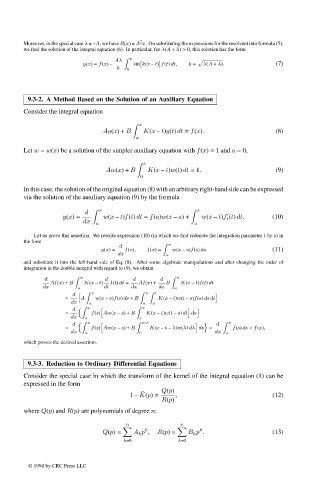Page 484 - Handbook Of Integral Equations
P. 484
2
Moreover, in the special case λ = –A,we have R(x)= A x. On substituting the expressions for the resolvent into formula (5),
we find the solution of the integral equation (6). In particular, for λ(A + λ) > 0, this solution has the form
Aλ x
y(x)= f(x) – sin k(x – t) f(t) dt, k = λ(A + λ). (7)
k 0
9.3-2. A Method Based on the Solution of an Auxiliary Equation
Consider the integral equation
x
Ay(x)+ B K(x – t)y(t) dt = f(x). (8)
a
Let w = w(x) be a solution of the simpler auxiliary equation with f(x) ≡ 1 and a =0,
x
Aw(x)+ B K(x – t)w(t) dt = 1. (9)
0
In this case, the solution of the original equation (8) with an arbitrary right-hand side can be expressed
via the solution of the auxiliary equation (9) by the formula
d x x
y(x)= w(x – t)f(t) dt = f(a)w(x – a)+ w(x – t)f (t) dt. (10)
t
dx a a
Let us prove this assertion. We rewrite expression (10) (in which we first redenote the integration parameter t by s)in
the form
d x
y(x)= I(x), I(x)= w(x – s)f(s) ds (11)
dx a
and substitute it into the left-hand side of Eq. (8). After some algebraic manipulations and after changing the order of
integration in the double integral with regard to (9), we obtain
d x d d d x
AI(x)+ B K(x – t) I(t) dt = AI(x)+ B K(x – t)I(t) dt
dx a dt dx dx a
d x x t
= A w(x – s)f(s) ds + B K(x – t)w(t – s)f(s) ds dt
dx a a a
d x x
= f(s) Aw(x – s)+ B K(x – t)w(t – s) dt ds
dx a s
d x x–s d x
= f(s) Aw(x – s)+ B K(x – s – λ)w(λ) dλ ds = f(s) ds = f(x),
dx a 0 dx a
which proves the desired assertion.
9.3-3. Reduction to Ordinary Differential Equations
Consider the special case in which the transform of the kernel of the integral equation (1) can be
expressed in the form
Q(p)
˜
1 – K(p)= , (12)
R(p)
where Q(p) and R(p) are polynomials of degree n:
n n
k k
Q(p)= A k p , R(p)= B k p . (13)
k=0 k=0
© 1998 by CRC Press LLC
© 1998 by CRC Press LLC
Page 466

